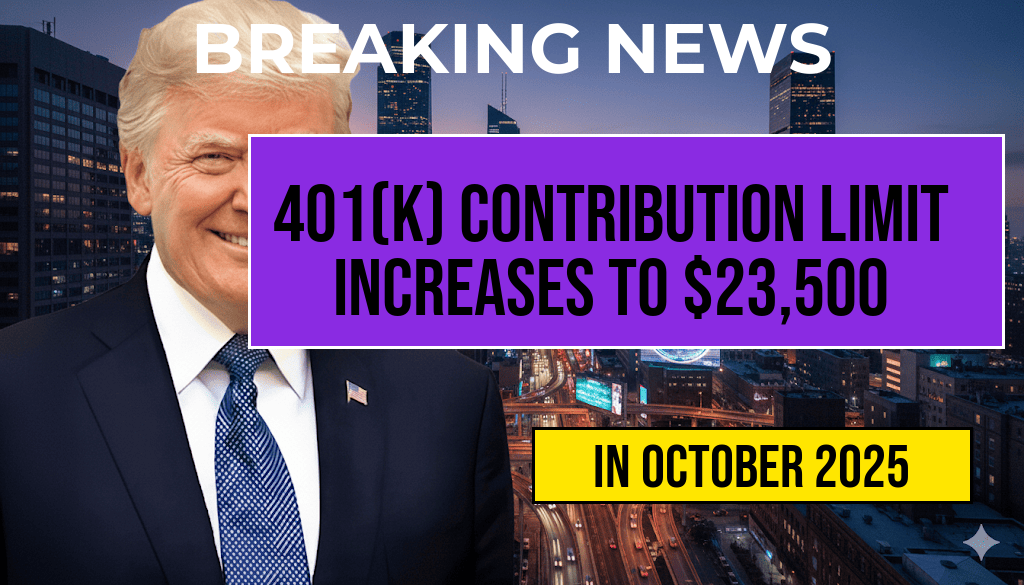In a significant update for retirement planning, the Internal Revenue Service (IRS) announced that the contribution limit for 401(k) plans will rise to $23,500 in 2025. This increase, which marks a notable change from previous years, aims to help employees save more for their retirement in response to rising living costs and inflation. The new limit represents a $3,500 increase from the 2024 contribution cap of $20,000. Additionally, employees aged 50 and over can continue to take advantage of catch-up contributions, further enhancing their savings potential. This adjustment is part of the IRS’s annual review of retirement plan contributions, reflecting economic trends and encouraging long-term financial security for American workers.
Understanding the 401(k) Contribution Limits
The 401(k) plan is a popular retirement savings option for many employees in the United States. It allows workers to set aside a portion of their salary before taxes, which can grow tax-deferred until withdrawal. The increase in contribution limits for 2025 provides employees with an excellent opportunity to bolster their retirement savings.
Key Changes for 2025
- New Contribution Limit: Employees can contribute up to $23,500.
- Catch-Up Contributions: Workers aged 50 and older can make additional contributions, although the exact amount for 2025 is yet to be finalized.
- Inflation Adjustment: The IRS adjusts limits periodically based on inflation and cost-of-living increases.
Implications for Retirement Planning
This increase in contribution limits is particularly significant given the current economic climate. With inflation affecting everyday expenses, having the option to save more can greatly enhance financial security in retirement. Financial advisors recommend that employees take full advantage of these increased limits to maximize their retirement funds.
Benefits of Higher Contribution Limits
- Increased Savings Potential: Higher limits allow employees to contribute more, leading to larger retirement funds.
- Tax Advantages: Contributions to a 401(k) reduce taxable income, offering immediate tax benefits.
- Employer Matching: Many employers match contributions up to a certain percentage, amplifying the benefits of higher contributions.
The Role of Catch-Up Contributions
For employees approaching retirement age, catch-up contributions are a crucial feature of 401(k) plans. These additional contributions enable individuals aged 50 and older to enhance their savings as they near retirement. In 2024, the catch-up contribution limit is set at $7,500, and while the exact amount for 2025 is still pending, it is expected to increase.
Planning for Retirement in 2025
As employees prepare for the 2025 contribution limits, it is advisable to evaluate their current savings strategy. Here are some steps to consider:
- Review Current Contributions: Assess how much you are currently contributing to your 401(k) and consider increasing it in light of the new limits.
- Utilize Employer Match: Ensure you are contributing enough to take full advantage of any employer match available.
- Consult with a Financial Advisor: Personalized advice can help tailor a retirement strategy that aligns with your financial goals.
Conclusion
The increase to $23,500 for 401(k) contributions in 2025 offers a valuable opportunity for employees to enhance their retirement savings. By understanding the changes and planning accordingly, workers can take proactive steps toward achieving their long-term financial goals. For more information regarding retirement savings and IRS guidelines, visit the IRS Retirement Plans page or read about it on Forbes.
Frequently Asked Questions
What is the new contribution limit for 401(k) plans in 2025?
The new contribution limit for 401(k) plans in 2025 is $23,500, which represents a significant increase from previous years.
How has the contribution limit changed from previous years?
The contribution limit has seen a notable increase, allowing employees to save more for retirement compared to earlier years, where the limit was lower.
Who is eligible to contribute to a 401(k) plan?
Generally, all employees who participate in their employer’s 401(k) plan are eligible to contribute, subject to the new limits established for each year.
Can employees over the age of 50 contribute more than the limit?
Yes, employees over the age of 50 can make additional “catch-up” contributions, allowing them to save even more for retirement beyond the $23,500 limit.
What are the benefits of contributing to a 401(k) plan?
Contributing to a 401(k) plan offers several benefits, including tax advantages, employer matching contributions, and helping employees save for their retirement.












